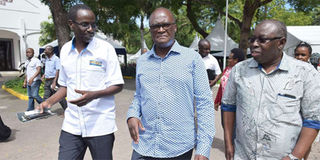Government out to lower cost of crucial projects

Transport Cabinet Secretary James Macharia (centre) with Material Testing and Research Division Chief Engineer Stephen Kogi (left) and Kenya Roads Board Executive Director Jacob Ruwa (right). PHOTO | WACHIRA MWANGI | NMG
What you need to know:
- Housing, and transport are among the key areas in which the State is seeking help from industry players.
The government is looking to researchers, contractors and suppliers to help it lower budgetary costs by at least 25 per cent to enable it to achieve various development projects.
Transport and Infrastructure Cabinet Secretary James Macharia said they should consider key areas such as housing, infrastructure and research.
Addressing an international conference on transport, roads and research in Mombasa, Mr Macharia said cutting costs will enable the government to carry out projects without digging deep into its coffers.
“I am glad to see that what you are discussing here on reducing the cost of doing these projects is at least 25 per cent across the board. It is important to keep the cost low. Whether it is housing, roads, railways or even airports or research, the cost must be brought down,” he said.
The CS said the government implements projects based on demand, but high costs complicate matters and must, therefore, be reduced to an affordable level.
“Whereas the government would like to engage suppliers and contractors in projects, it is extremely important to look at both sides of the divide. It is basically demand and supply, with the government having great demand for projects on behalf of its citizens,” Mr Macharia said.
Meanwhile, Ms Rita Kavashe, chairperson of the Kenya Roads Board on Sustainable Transport Development, said that the government had invested heavily in developing and maintaining the country’s transport infrastructure. for the last 15 years.
“In 2017, the transport sector contributed five per cent of the GDP but its contribution is declining as the contribution of other sectors, particularly ICT, increase. Roads contribute the most to the GDP, with a modal share of more than 60 per cent,” she said.
Ms Kavashe noted that demand for transport is growing faster than the supply of infrastructure, adding that about 200,000 new vehicles are registered annually.
“This represents an eight per cent growth while the construction of new roads while the rehabilitation of existing ones is around 1,300 kilometres annually, representing one per cent of the existing road network, which currently stands at 161,000 kilometres,” she added.
Infrastructure PS Julius Korir said the ministry, in collaboration with cement manufacturers and promoters of proprietary products, is researching on ways of providing quality, low-cost hydraulic road binders (HRBs) to build low-volume roads.
“If this succeeds, it will support our strategies for providing cost-effective, low-volume road infrastructure. In addition, the ministry will from time to time review manuals and standards to incorporate emerging technological trends,” he said.
Kenya Roads Board Executive Director Engineer Jacob Ruwa said there was a need for engineers to encourage community participation in implementing projects and programmes in the transport sector as as agreed at the last International Conference on Transport and Road Research (iTRARR) in 2016.
“A resolution was made at the last conference to promote organised public transport systems in the major cities in sub-Saharan Africa. r (SSA). I’m happy to report that the Nairobi Metropolitan Area Transport Authority (NAMATA) is now in place and is formulating a sustainable integrated public transport strategy comprising bus-rapid transit and commuter rail,” he said.
Earlier, Mr Macharia had told the delegatesthat many countries, including Kenya, have not been able to fully develop their infrastructure despite spending huge amounts to improve them.
He said the shortage of infrastructure remains one of the biggest challenges for countries keen to develop.
“Infrastructure is capital-intensive and whichever country you go to, whether in the Far East, the US, Europe or South America, any infrastructural project you see is capital-intensive.
But because the citizens in those countries require infrastructure, we cannot stop doing infrastructure and so the deficit continues to get wider by the day,” the CS said. He added that Kenya has borrowed and spent billions of shillings on infrastructural development to improve its citizens' lives.
The three-day conference was organised by the Kenya Roads Board and Material Testing and Research Division to enhance coordination of transport related research efforts within the region. It was attended by 396 delegates from 17 countries in Africa, South East Asia, and Europe.




